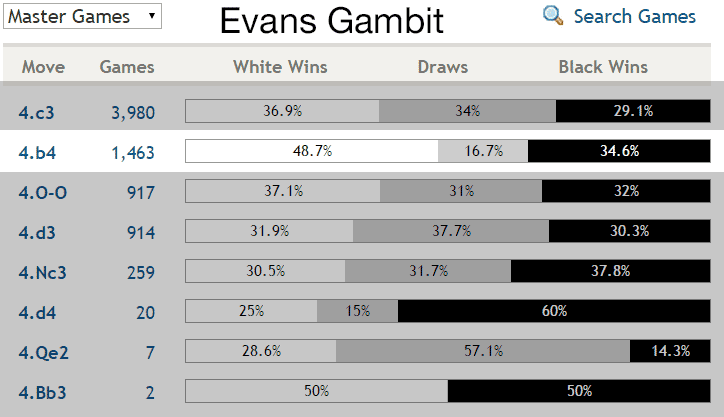
Tonight’s lecture is not so much a lecture as it is some time to play with a few practical goals in mind – and I kept it secret so that no one could go ‘book up’ in advance. We’re gonna work on blunders again in a new way and we’re gonna work on the idea of time and attack… with gambits!
Tonight is Gambit Night! It’s a theme night! We’re going to take a look at a couple of gambits and everyone will play some games from the same start position.
First up is the Evans Gambit. Along with the Benko Gambit, the Evans has a reputation for being completely sound. This one was invented in the early 1800s by a Welsh sea captain, and it has been played ever since, even at very high levels.
Take a look at this chess.com chart:

Nakamura played an Evans in the 2012 US championship and here’s a game between Anand and Kasparov in the 90’s:
Here is the main line start position we are going to look at:
Now here’s the ‘mystery trick’ for the evening…! Everyone pair up with a stronger player and a weaker player – no two beginners, no two veterans. I want the stronger player as black. Set up this position.
While you’re doing that:
Tonight is a double-barreled adventure! We’re gonna work on preventing blunders at the same time.
Blunders and CCTs
Remember we talked about making habits that might help you slow down the blunders? I’ll bet you a dollar you haven’t got that figured out yet. Neither have I. It’s *tough*.
What I’ve been doing – and I think many people try this – is simply to catch myself before I make my move and look one more time for basic blunders. That is enough most of the time, but to get ‘ironclad’ about it there are two tasks:
1) Make it habitual. Something you do *every* move.
2) At minimum check what coaches call ‘CCTs’: Checks Captures and Threats.
So we’re gonna practice moving with *only* the CCT check!
Here are the rules: I call out ‘move!’ and you have to move immediately! Attackers attack, defenders defend!
But if you blunder, you must stand up, call out ‘blunderman!’, bow to the room, then take your move back to try again. This means you almost can’t plan – just try to find a move that is not a blunder!
REMEMBER: Don’t plan – just look for Checks, Captures and Threats!
When your game is over, call it out. +++ So – was the gambit looking successful?
Is anyone nervous? If you are, get up, shake it off, go get a drink of water, etc., and come back. Part of avoiding blunders is staying calm.
Switch sides and start over!
+++
Do you remember when we looked at the Muzio Gambit? Giving away a whole piece on move six!? The idea was to gain time for an attack, right? That’s what gambits are all about. How much is time worth?
Well, I’ll tell you I’ve about made a living out of taking the gambit and just keeping it. When I started playing seriously I gave away gambit pawns ALL. THE. TIME. So both sides are totally legit. Learning to defend and learning to attack *have* to happen in gambits, right?
So are you up for doing another? This time it’s on e I guarantee no one has heard of: the Bongcloud Gambit!
I can hear it already – what the heck??? Apparently Lenny Bongcloud was a long time chess.com member and he made this up just to have bonkers fun.
Your goal is to practice CCT AND for white to march the king to the 8th rank!! Can anyone make it???
Ready? MOVE!
Want *more* crazy? Look up ‘The Hillbilly Gambit’, the ‘Halloween Gambit’, or the ‘Englund Gambit’.
For true whackiness, try playing 1.f3 and 2.Kf2 (!) or the Ammonia Opening, 1. NH3. (Not real gambits – you are ‘gambiting’ your own development! Can anyone guess how that might work!?)
And here is the Orangutan Colorado, invented, naturally enough, by combining the Orangutan 1.b4 with the Colorado Gambit, this one from from a blitz game on chess.com:
Check out https://en.wikipedia.org/wiki/List_of_chess_gambits which, sadly, is quite incomplete…!
